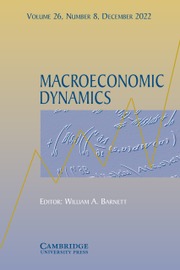No CrossRef data available.
Article contents
Technology shocks, directed technical progress and climate change
Published online by Cambridge University Press: 14 May 2025
Abstract
Technical progress is considered a key element in the fight against climate change. It may take the form of technological breakthroughs, that is, shocks that induce significant leaps in the stock of knowledge. We use an endogenous growth framework with directed technical change to analyze the climate impact of such shocks. Two production subsectors coexist: one subsector is fossil-based, using a non-renewable resource, and yields carbon emissions; the other subsector uses a clean, renewable resource. At a given date, the economy benefits from an exogenous technology shock. We fully characterize the general equilibrium and analyze how the shock modifies the economy’s trajectory. The overall effect on carbon emissions basically depends on the substitutability between the production subsectors, the initial state of the economy, and the nature and size of the shock. We notably show that green technology shocks induce higher short-term carbon emissions when the two subsectors are gross complements, but also in numerous cases when they are gross substitutes.
Information
- Type
- Articles
- Information
- Copyright
- © The Author(s), 2025. Published by Cambridge University Press

